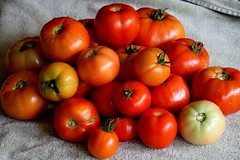
It's still hard to believe we're already a month into fall. Since August, I've been neglecting this blog, and though I tried to hammer something out last month, it just didn't happen.
Things are slowly beginning to wind down. I've pulled the carrots, the bean towers, the peppers, and the eggplants. All the tomatoes are gone, save for the plants on the south side, which seems to retain heat. I've covered the tomato, solanaceae, and cucurbitaceae boxes with a layer of compost, dug it in with the soil a bit, and planted garlic, shallots, and multiplying onions from Territorial Seeds. I've chosen not to plant any flowering bulbs this year, though I will be switching out a couple tulip patches.
I haven't really been able to get a leg up on fall cleanup in the front yet. As you can see from the photo on the left, our sugar maple has taken on its beautiful golden fall hue, which means lots of leaves to clear up along our curb. But the weather has been dismal, lots of rain and cold, so it hasn't really been ideal.
Once we are able to rake the leaves up, there will be lots more fodder for the compost pile, after which that pile will be "decommissioned" and a new one will begin where last year's was spent. I'm pretty pleased with my compost this year. It has been a year in the making, and I am still picking out the big chunks of wood, branches, and spruce cones. But I seem to have a lot more compared to last year, so much that I'm thinking of places other than the vegetable garden to apply it.
I guess once all that's finished, it's time to start thinking about plans for next year, time to tend The Imaginary Garden. Well, I am trying to follow a crop rotation model, so I have some limits to work within. Next year will mean lots of brassicaceae and papilionoideae, so I've been thinking of bok choy and cabbage, along with something for dry bean use. I'm getting better at thinking ahead and figuring out what to plant that can actually be used. I want to work even harder at planting open-pollinated varieties so that I can get to a point of at least quasi-self-sufficiency (I'm not sure I'll ever be at the fully self-sufficient level).
In the meantime, I'm going to read more blogs by self-sufficient gardeners and farmers, as well as local foodies. I want to read more books about local and slow food and perhaps make an effort to try the few gourmet restaurants in this area that specialize in it. I'm planning also to sign up with a local CSA, which might involve volunteer hours with a local farm. It might be a good way to learn how others work, especially at a large scale.
What's funny is I used to think of gardening as more of a seasonal task, but now I'm thinking of it more as year-round and ongoing. What are your plans for next year?































